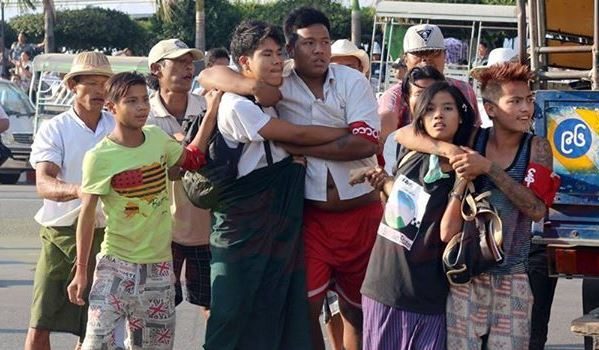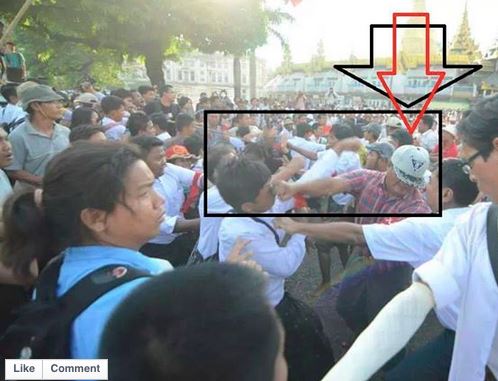Image source. Banner image source.
Tonight, students are barricaded in a monastery outside Yangon.
A few weeks ago, I sat with friends and colleagues in a teashop near where a branch of the Irrawaddy River sidles past Pathein Town. Passing the night with talk and tea, my colleague suddenly interjected: hey, Matt, there is a fire in your township.
I leaned over the corner of the small table to read the screen on her phone; the fire was in my township, but the Facebook post said that it was across another branch of the Irrawaddy River. No danger for my friends or my apartment, that was clear. But the village name and extent of the fire was less clear; each of the three stories that we read online differed. Different village names, different sizes of fire; a boat fleeing the flames had sunk in the middle of the river, too. All hands lost! Maybe.
Worried though relieved, I excused myself to check with friends back in the city. Standing outside hoping for a connection not yet fatigued by the teashop’s metal roof, my call fought its way through. The conversation lasted long enough for Aung Aung to confirm the fire. I stood in the dark and looked at trash in the muddy canal. A second call lasted long enough to confirm everything in our ward was okay. Third and fourth calls dropped. I left the issue to rest and went inside for more tea.
Last week, Myanmar police forces blockaded student demonstrators in a monastery outside Yangon. They’d been marching for over a month now, starting some 300 miles away in Mandalay. Other students’ groups had also marched on the old capital. Shades of history. Friends and heroes identified by the year of their protest.
At the end of January the Internet had seemed unusually slow, even for Myanmar. What’s up with the Internet? I asked an online activist friend. It’s the government’s response, she said. They don’t want news of the marches to spread. Then the connection to Facebook went down for a few hours, shades of July 2014. Later we heard that the network had been down worldwide for those hours, too. But the alternative seemed credible. Students’ movements have a special power in Myanmar; only two other groups can marshal numbers comparable or larger.
Eventually the Internet seemed to go back to its regular inconsistencies. Each day, I read updates from the marchers and looked at their photos. To make that easier the online activists coded a mobile phone ap to aggregate news about the marches. It was brilliant and beautiful and our artist friends illustrated it to make it twice beautiful. I never did get it to work on my phone, but updates about the marchers kept coming.
And then, 85 miles from Yangon, police barricaded students in the monastery.
Later last week, demonstrations started downtown. Marches in other cities had started and stopped. Negotiations with the government had started and stopped. Supporters of the students gathered to show solidarity. Don’t respond to the students with violence, said some of their banners. Thugs ushered by police beat them and threw them into trucks in the shadows of Sule Pagoda. Familiar ground.
That evening, photos of the streets being cleared took over my Facebook newsfeed. A fist meeting a face, arrested at contact. A young man and a young woman watching the camera, choked by violent arms marked with red bands reading ‘duty’ and ‘discipline.’ Who are these thugs with the red armbands?
Quickly the most compelling photos began to repeat themselves, chopped, cropped, zoomed in, with text overlaid. Fist meets face. Chokehold. Fist meets face. Chokehold. Police batons in mid swing. Chokehold.
Who are these thugs with the red armbands? This is not a rhetorical question. Memories of September 2007 harken to the power of photos in a crowd; in the months after those demonstrations, marchers were quietly identified, questioned, arrested. Faces in photos attached to bodies on familiar ground.
This night on Facebook, neighborhoods and names quickly became attached to the photos. And in those photos a face that I recognized, maybe two. The next morning, more names, addresses, phone numbers. Each red armband guy was paid 8,000 kyat, a friend told me, people are calling them wage labour thugs. I toggled between work and my newsfeed.
On the way home I stopped in front of the monastery near my apartment. In the shade of large banyan trees there is a chin lone court where men gather in the evening to play. I needed to check about a string of calls from Htoo Lay that I’d missed the previous night. I could have called but also I wanted to ask about the faces I recognized.
‘Min, I called you but you didn’t answer,’ he said. It was a little early and the chin lone game was fresh. A three-on-three friendly match between his younger brother and some others; high quality play but not serious enough for him to join yet. ‘Sorry, sorry, sorry,’ I said. ‘I can’t hear the ringer on my phone.’
‘We had a lot of pickled mango last night. It was special so we wanted to give you some but now it’s all gone.’ I told him I was sad to miss it and we sat on a section of unused timber in the dust watching the match. After a little while I asked him if he’d heard anything about the people who beat up the demonstrators.
‘Yes! Remember the fire across the river a few weeks ago?’ I said I did and looked around for his older brother, who could verify that I’d called that night. ‘After the fire we prepared a lot of curry to donate to them. Duck egg curry. But when we arrived they already had a lot of food. Pork curry. They didn’t even eat our duck egg curry; they were feeling too oily.’ One of my favourite Burmese words is the one used to describe the feeling after eating too much oily food.
I thought maybe I’d lost the thread of the conversation. But on Facebook I’d seen this area across the river mentioned as the home of some red armband thugs, so I hung on. ‘Then today, we heard that those same guys are the ones hitting the students. So we don’t want to donate to them anymore. Maybe we should have given them that pickled mango!’ Pickled mango is an especially nice condiment when you are eating too much oily food. Had I lost the thread again? I wasn’t sure if he’d just deployed an impressively executed punch line or if he meant to emphasize that people on the other side of the river were being taken care of better than 8,000 kyat.
I asked him about the two men in the photos. Htoo Lay doesn’t use Facebook but he said he’d heard about them and explained who they were. His brother’s match ended. We made plans for me to join him and the others for donations to a monastery on Sunday and then I walked the rest of the way home.
That night, 85 miles from Yangon, students were still barricaded in the monastery.
Today, a friend showed me the front page of a daily newspaper. Some of the red armband thugs want to apologize, said the headline. They are being shamed by the whole country, she said, and also their own communities. In the article, a resident of the village across the river where there had been a fire said, ‘People who donated to us will feel they have been watering a poisonous tree.’ I guess Htoo Lay would agree. One of the thugs said he had not known what he was being called to do. The story also quoted his pregnant wife. She does not want people to tell their child that its father is a bad man.
‘I wonder if this is the power of social media,’ I said to my friend. I said it in English with the lazy grammar that can sound like a question but isn’t, really. When we got back to the office that afternoon, another friend showed us a photo on Facebook. A row of dead bodies in monk’s robes. A grainy photo with a caption saying that they had been killed by Muslims. Other posts had other captions and more photos, showing the wreckage of a bus on the highway.
Tonight, the students are barricaded in a monastery outside Yangon.
Matt Schissler is based in Yangon, where he manages the Myanmar Media and Society (M.MAS) Research Project for St Antony’s College, Oxford University.
 Facebook
Facebook  Twitter
Twitter  Soundcloud
Soundcloud  Youtube
Youtube  Rss
Rss 
